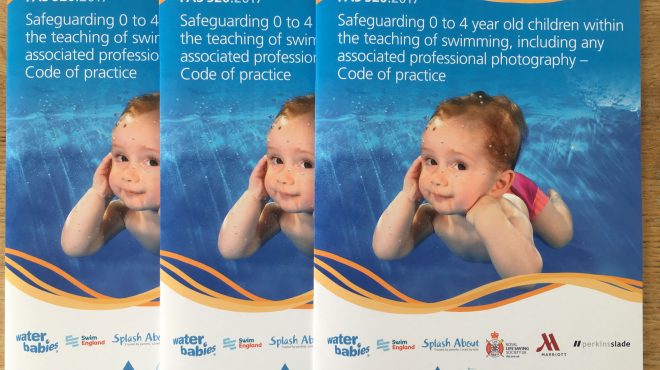Drown-Proofing Your Child – The Baby Swimming Industry Speaks Out

Evidence for or against drown-proofing a child is necessary, but it would be unethical to subject babies and toddlers to these methods to assess the methodology. Therefore, a new report titled ‘Sink or Swim’ has been published by the UK baby swimming industry today to argue the case against drown-proofing teaching methodologies based on authoritative scientific research.
All the major UK bodies involved in baby swimming have come together to speak out and warn parents about the dangers of ‘survival’ methods being taught to young infants. This united call to action comes after videos, which show distressed young learners being taught these ‘drown-proofing’ methods, going viral across social media and gaining increasing media attention in the UK.
Baby swimming is a wonderful sensory activity; as such it has rapidly become a cultural must of early parenting because of all the known benefits it provides, including the progressive teaching of age-appropriate lifesaving skills. But in recent times, videos have been circulating the internet about so-called drown-proofing methods for babies. These sink or swim methods actively promote the de-risking of drowning accidents for toddlers through classes in which learners are taught, and forced, to roll-on-the-back-to-float.
While some may see this highly stressful, forceful method of teaching as being ‘a means to an end’, the wider baby swimming profession argue that there is an urgent need to examine if these drown-proofing techniques, which are being promoted to parents as insurance for their child’s water safety, are actually safe, acceptable and effective. The industry consensus is that this evidence must be based on current scientific research – and not the views of parenting experts who are not recognised scientists.
Furthermore, it must be recognised that confidence imparted to a child by either baby swimming classes or water survival techniques should not substitute parental supervision.
Dr Francoise Freedman, a medical anthropologist at the University of Cambridge and the founder of Birthlight, is considered one of the world’s leading experts on baby swimming and she says in the report: Drown-proofing methods through floating have been around for decades, but the techniques are becoming more prevalent and have recently caught widespread international attention – leading to us, uniting as an industry in the UK to speak out about our concerns.
Francoise explains that the causes for concern are that this methodology is based on a conditioning that is unnecessarily aggressive. She explains: Conditioning (forcing) a baby or toddler to float relies on extreme traumatic methods and sadly no amount of praise will compensate for the memory of inflicted pain – it just gets pushed into the recesses of our brain, where it is recorded. While some children will escape unscathed, for others, the trauma may resurface in later years and cause a fear of the water. And because we do not know who is at risk, we have to question if it is worth doing; and the simple answer is no, based on scientific evidence and statistics.
Kaylë Burgham, Head of Aquatics at STA, the UK’s leading experts in baby swimming teaching and a registered charity dedicated to the teaching of swimming and lifesaving skills, adds: While we wholly agree that teaching water safety is essential – it’s at the core of everything we do – we morally cannot agree with this drown-proofing methodology. There are far gentler child-focussed swimming teaching and water safety practices readily available that parents are advised to follow.
For STA, the potential neurologically harmful practices of forceful conditioning, as outlined in the report, are simply not justifiable in any circumstance.
Michael Dunn, RLSS UK Deputy Director of Education and Research said: As the drowning prevention charity, the Royal Life Saving Society UK advises against the use of these types of infant self-rescue or survival programmes. The RLSS UK has taken this position following close scrutiny of the evidence base which shows no proven drowning reduction benefit to the infant, and which has raised significant concerns nationally and internally about the potential for an increased risk of drowning during or following participation in these types of programmes.
The Society does support parent and baby sessions, and basic water safety and swimming lessons for children starting whenever the child is developmentally ready to engage with the activities fully and comfortably.
Swim England Learn to Swim Director Jon Glenn, said: A child’s first experience of water and the pool environment should be positive, fun and memorable. It is important that children become comfortable and safe in the water at an early age, but any form of forced techniques are unacceptable. Not only can these be physically harmful, they may also result in children being put off going in the water, leading them to miss out on a lifetime of fun that learning to swim can bring. This is such an important area that it is good to see the whole sector coming together to support this report.
Francoise concluded the report by saying: Our message is that drown-proofing methods have no place; their statistical benefits are unproven and their potential developmental risks are compelling. It is a moral duty for all aquatic teachers to inform parents that drown-proofing methods have possible detrimental effects. ‘Each child matters’ and in the promotion of water safety, this is best served by ensuring the wellbeing of all children.
The UK’s leading baby swimming providers, Water Babies, Puddle Ducks and Turtle Tots are also supporting the publication of the new ‘Sink or Swim’ report.
Paul Thompson, Co-Founder of Water Babies, said: We are fully aware of the distress to children the self-rescue technique can cause and regard it as an aggressive, unproven method to make babies ‘drown-proof’. Parents who choose this method are well-intentioned, but have unfortunately been misguided. We practice a much gentler, nurturing and holistic approach that enables little ones to develop physically, emotionally and cognitively at an appropriate rate. We have had clients come to Water Babies having used the self-rescue technique and in many cases the children are petrified of water. Instead, we teach safety, but also encourage children to enjoy the sheer fun of swimming with their family for the long-term.
Ali Beckman, Technical Director of Puddle Ducks, says: Personal survival skills should be an integral part of all swimming lessons but there are ways to do this without forcing a child to go through these methods which not only lead to trauma but also a fear of water in general. Forcing rotation movements can also have an impact on a child’s physical development as it can interfere with the natural development of postural reflexes. There are proven safe, effective and enjoyable teaching methods to allow children to learn how to save themselves, which will also help promote a love of swimming for life.
Gabrielle Lixton, Founder of Turtle Tots, said: At Turtle Tots we fully endorse and promote a gentle, child focussed, child led philosophy. This is the bedrock of our beliefs and all teaching practices, including the teaching of life saving and water safety skills. We believe that teaching our babies and children to swim should be an enjoyable bonding experience. We do not morally agree with the technique of drown proofing and it is the polar opposite of our methodology. Drown proofing is a conditioning technique that is both dramatic and traumatic for a child which is totally unnecessary in teaching water safety skills. We are passionate about teaching babies to swim and water safety skills within a safe, happy and child focussed environment.



